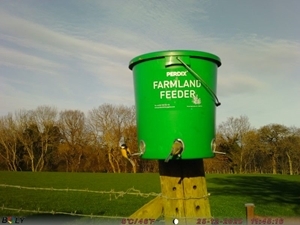 “Over-winter supplementary feeding is one of a number of methods that can be easily implemented on farm and proven to successfully boost farmland bird winter survival,” according to Matt Goodall, Game & Wildlife Conservation Trust (GWCT) Wales advisor.
“Over-winter supplementary feeding is one of a number of methods that can be easily implemented on farm and proven to successfully boost farmland bird winter survival,” according to Matt Goodall, Game & Wildlife Conservation Trust (GWCT) Wales advisor.
Funded by Natural Resources Wales (NRW) Shared Outcome Request in North East Wales - one of seven Area Statements in Wales – this project aims to raise awareness of methods that can be easily implemented on farms to halt and reverse farmland bird declines.
The project includes 25 farmers in Denbighshire and Flintshire, each putting up a feeding station and offering supplementary feed through the critical ‘hungry gap’ period from 1 Dec to 30 April,” says Matt, who aims to demonstrate how a very simple technique, with no impact on the daily management of the farm or its productivity, can make a big difference and could be routinely offered in the next agri-environment scheme.
Matt is undertaking advisory visits on each farm, discussing the year-round needs of farmland birds, and highlighting how farms can fine-tune their conservation efforts alongside their farm business.
“Quality habitat provision is still the corner-stone for conserving wildlife,” he says, but warns that it’s not the whole picture. “Supplementary feeding alongside good quality habitat such as a strip of wildlife cover crop has a much greater impact than the habitat alone.”
Although this concept has been proven previously outside of Wales and in an arable setting, Matt is adamant that this conservation practice is transferable to livestock farming in Wales.
“In fact,” says Matt, “Our research suggests that supplementary feeding in a grass-dominated landscape has a magnified impact and benefit compared to the same management in an arable setting due to the lack of seed availability in pastoral farming.
“Farmland birds have dramatically declined in Wales in recent decades and habitat provision through agri-environment schemes such as Glastir and Tir Gofal has not altered this trajectory. The story is more complex in that a balance between habitat quality and quantity, food availability and predation pressure is key.”
“As the farm support system - Basic Payment Scheme - is being phased out, payments for delivering public goods will replace it,” adds Matt, who believes that such initiatives offer a great easy way to increase and demonstrate biodiversity on farms and is one way of delivering a public good.
This initiative is only the first step in raising awareness and getting birds fed in the hungry gap, helping to halt the rapid decline in farmland birds seen in the recent past.
“The ultimate goal, however, is to enhance habitat and increase the number of farms taking part in supplementary feeding across Wales,” explains Matt, who is keen to see strips of seed-bearing cover crops next to a hedgerow and leaving a strip of rye grass to set seed is better than nothing.
“Done in conjunction with supplementary feeding, these measures can have a huge impact on farmland bird survival through the winter. We then need to consider what is needed during the rest of the year; nesting habitat, insect-rich habitat for chick rearing and habitat which provides cover from predators are all important,” concludes Matt, who has cameras located near the feeding station to see what birds are taking an interest.
Please do get involved in the eighth year of the Big Farmland Bird Count.
Ends
For further information on this press release please contact Matt Goodall on 07741 902021 or mgoodall@gwct.org.uk.
Notes to editors
The Game & Wildlife Conservation Trust – providing research-led conservation for a thriving countryside. The GWCT is an independent wildlife conservation charity which has carried out scientific research into Britain’s game and wildlife since the 1930s. We advise farmers and landowners on improving wildlife habitats. We employ more than 60 post-doctoral scientists and other research staff with expertise in areas such as birds, insects, mammals, farming, fish and statistics. We undertake our own research as well as projects funded by contract and grant-aid from government and private bodies.
For information, contact:
Eleanor Williams
Telephone: 07592 025476
Email: press@gwct.org.uk